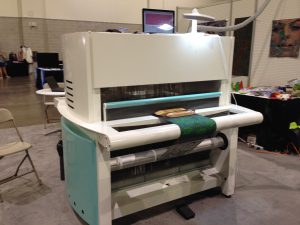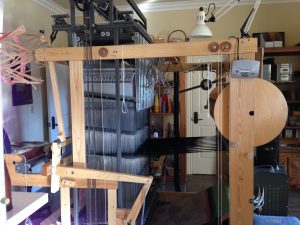In July, 2014, I was fortunate enough to spend 10 days studying, and weaving on, the two major brands of jacquard loom available to today’s handweaver: the AVL Jacq3G and Digital Weaving Norway’s TC-2 (Thread Controller-2) jacquard looms. I thought my comparison might prove useful to other weavers, so I decided to post it on my website. While I’ve done my best to verify all the technical information with the manufacturers, I can’t guarantee the accuracy, especially since features and pricing change over time.
In addition to this comparison page, I have also created two pages that delve into the details of the Jacq3G and the TC-2.
Look and Feel
Both the TC-2 and the AVL Jacq3G have a decidedly high-tech feel. The Jacq3G has a wooden frame, but the modules are exposed to view, so the loom looks like this:
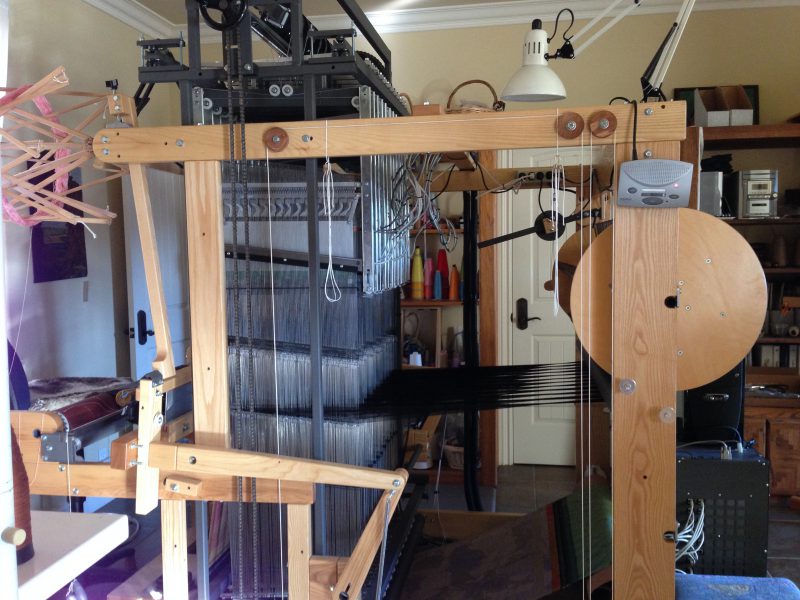
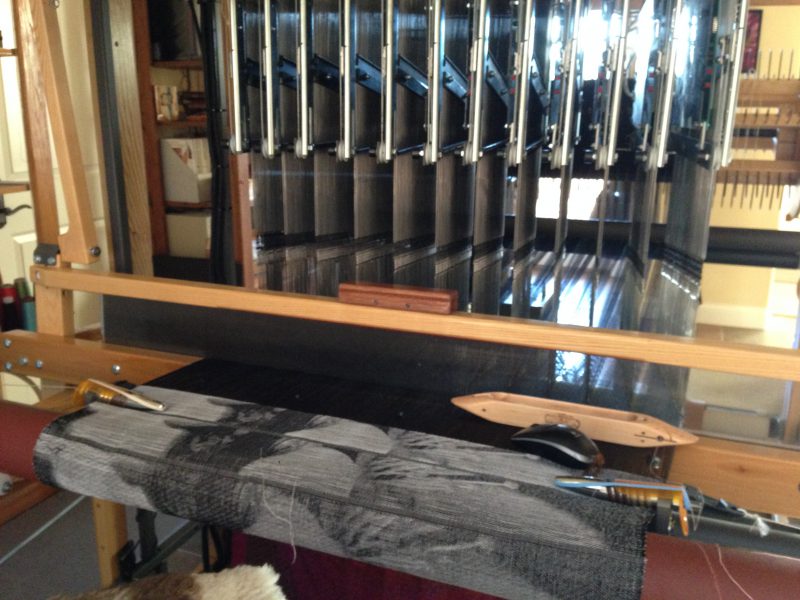
The TC-2, on the other hand, is entirely gleaming metal, painted in white and green (the green has been described as “1950’s retro”). All moving or electric parts are covered with enameled metal casings. While you can easily remove the panels if you need to tinker with the loom, by and large the “guts” are not exposed to the degree they are on the AVL Jacq3G.
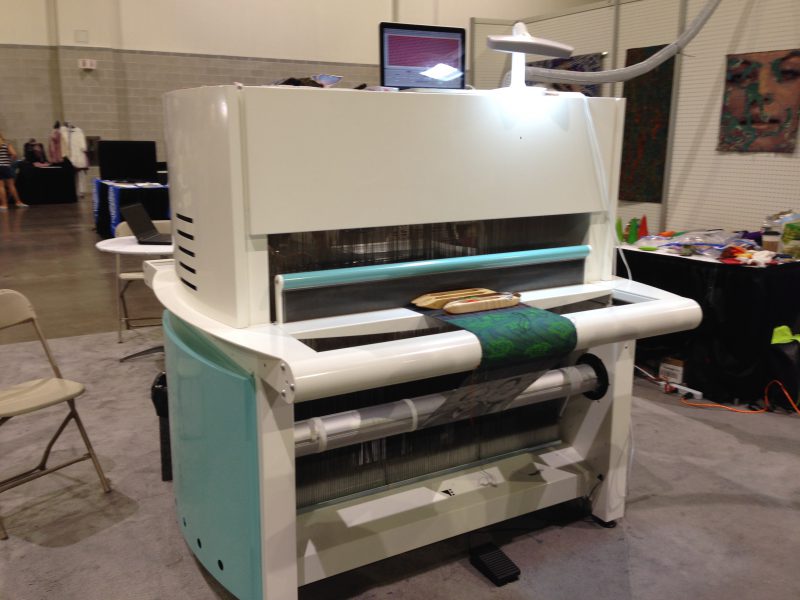
Accessories
The AVL Jacq3G comes with far more optional weaving accessories than the TC-2 jacquard loom. On the Jacq3G, you can have fly shuttles, sectional beams, an overhead beater, rolling temples, selvedge rollers, and the famous AVL sandpaper beam. None of these are available for the TC-2.
Sett
The Jacq3G and the TC-2 approach sett differently. The Jacq3G uses modules mounted parallel to each other. The Dial-A-Sett system (unique to AVL) enables you to tilt the modules relative to the front of the loom, expanding or reducing the spacing between hooks (and hence the available setts). Setts available run from 8 to 80 epi.
The TC-2, on the other hand, uses modules set into the frame, each of a fixed width (14.5 inches), with 15 hooks per inch. The modules can be arranged in any configuration you like; for example, if you have 12 modules, you can arrange the modules four wide by three deep, for a 56″ weaving width at 45 epi. Or you can arrange the modules 1 wide by twelve deep, for a 14.5″ weaving width at 180 epi. Or you can leave six modules out of the loom and weave 3 wide and two deep, 29″ x 30 epi. To reduce the sett from the maximum for a given configuration, one can either thread only the desired number of hooks per inch, or (if already threaded) use the automatic “thinning” function to leave some threads down continuously while weaving. This wastes a small amount of warp but saves a great deal of time by avoiding rethreading and resleying.
The advantage of the Jacq3G’s unique Dial-A-Sett function is that you can use all the hooks at any sett between 8 and 80 epi. On the TC-2, if you are weaving at a sett other than the maximum sett for a particular configuration, some hooks will go unused, requiring you to purchase more hooks than you will actually use. As an extreme example, if you are weaving a warp 15″ wide at 18 epi on the TC-2, you will need a configuration two modules wide and two deep ““ a total of 880 hooks ““ in order to weave 270 threads. With the Jacq3G, you would need only 270 hooks, and simply adjust the sett up or down using the Dial-A-Sett.
The downside to the Dial-A-Sett mechanism is that far fewer hooks can be placed within a given weaving width. The 48” A-series frame, for example, allows a maximum of 12 modules – 1,440 hooks. This reduces the weaving width substantially when weaving with fine threads.
The maximum sett recommended for the Dial-A-Sett is 80 ends per inch, and the minimum is 8 epi. On the TC-2, there is no minimum sett and the maximum is 180 epi. AVL has indicated that higher setts are feasible with a custom loom.
Setup
Both looms can be beamed normally for the type of warp beam. (The Jacq3G offers a choice of sectional or plain beams; the TC-2 currently offers only a flanged plain beam.) The new warp can either be threaded normally or tied onto the old warp. On the Jacq3G, threading is quite laborious, but since the loom does not need to be reconfigured to change setts, threading really only needs to be done once ““ after that, one can simply tie on to the previous warp and pull through.
On the TC-2, threading is reputedly easier (I didn’t get a chance to test it), but must be done every time the module configuration is changed. Of course, if you are not changing the configuration of the modules, you can simply tie on and pull through.
The TC-2 has a motorized warp beam advance, allowing you to wind on using a foot pedal to start and stop the motor. This can be quite handy, as it frees you from the warp beam crank and allows you to view the warp beam directly while warping.
Adjustments
In general, the Jacq3G requires more manual adjustments than the TC-2. While both looms can be gotten with an auto-advance system, the Jacq3G’s auto-advance is a mechanical device that advances the cloth a tiny fraction of an inch every time the beater is brought forward. The amount of the auto-advance must match the desired number of picks per inch, so some fiddling in the first few inches of the warp is usually needed to get the auto-advance adjusted properly.
With the TC-2, the auto-advance system operates using a sensor that sits near the fell of the cloth and detects the beater as it reaches the fell. As the cloth builds up on the loom, the fell advances, and eventually the beater fails to pass the sensor. At this point, the sensor activates the auto-advance and the warp is advanced a little bit (the exact amount of the advance can be set using the computer).
Similarly, the warp tension is set using a mechanical weight on the Jacq3G, and is computer-controlled (using a sensor located on the warp beam) on the TC-2.
Weaving Speed
Both the AVL Jacq3G and the TC-2 are easy to weave on, with a foot switch to change the sheds. I timed the TC-2 at about 960 picks per hour on a 14.5″ warp with a single shuttle; that is probably close to the maximum speed for that loom. I unfortunately did not time the Jacq3G, but the speeds were roughly comparable in my memory.
Noise Level
Computer-driven looms in general are not terribly quiet, but both the TC-2 and the Jacq3G were relatively quiet. It was easy to talk while weaving on both looms.
Cost
The base cost of the Jacq3G is considerably lower than the base cost of the TC-2. A 30″ A-series frame Jacq3G with 3 modules (360 hooks), air lift, one plain beam, and bottom swing beater (plus crating and handling) costs USD $25,020.95 before shipping and taxes. The TC-2 “base model” has a 29″ weaving width and two modules, 440 ends total, for NOK 192,720 (approximately $30,668 USD as of July 31, 2014). When you add in the cost of shipping from Norway to the U.S., the approximate cost is about $33,000. (There are no U.S. import duties on looms, but your state may charge use tax when the loom enters the country.)
Offsetting the low base cost of the Jacq3G is the higher price per hook. A 120-hook module for the AVL Jacq3G costs $3,848 (price current as of July 31, 2014), or approximately $32/hook. A 220-hook module for the TC-2 costs NOK 18,000 (approximately $2,863 as of July 31, 2014), or approximately $13/hook.
While there are a ton of variables that will impact the cost of either loom, on a strictly hook-by-hook basis, the Jacq3G is cheaper up to about 850-900 hooks, and after that the TC-2 becomes cheaper.
(These are all based off list price, before manufacturer discounts, if such things actually happen.)
Reliability
While the TC-2 is still too new to have much of a track record (at least among weavers I know), its predecessor, the TC-1, has a better reputation than the Jacq3G in the handweaving community. When I inquired on the WeaveTech mailing list, I got enthusiastic reviews from three happy TC-1 owners and recommendations from several others who knew happy TC-1 owners. I heard from one happy Jacq3G customer, but was told of at least two Jacq3G owners who had needed serious work to get their looms working or who were unable to get their looms working. While anecdotes are not the same as data, the anecdotes are suggestive.
Technical Support
Up until recently, AVL had the home-court advantage for buyers in the U.S., as AVL is based in California and Digital Weaving Norway is based in, well, Norway. However, Digital Weaving Norway has now founded an offshoot, Digital Weaving USA, and Cathryn Amidei (located in Michigan) will be providing technical support for the TC-2 in the USA.
Details
More information on both looms can be found on my AVL Jacq3G in a Nutshell and Digital Weaving Norway TC-2 in a Nutshell pages.
